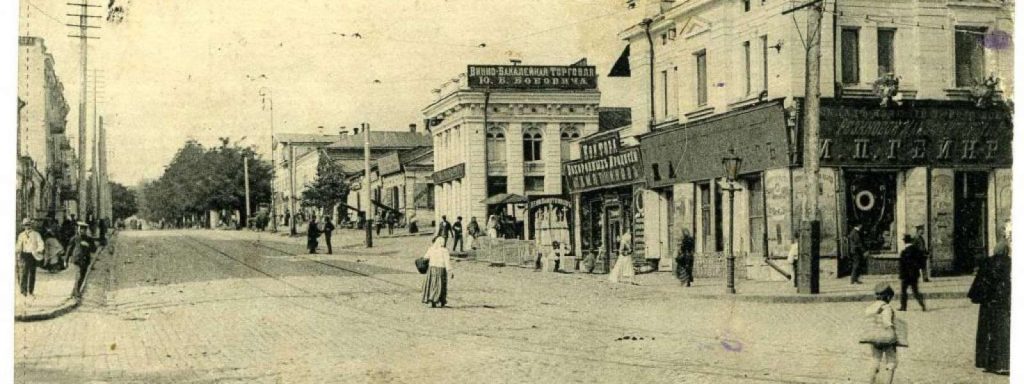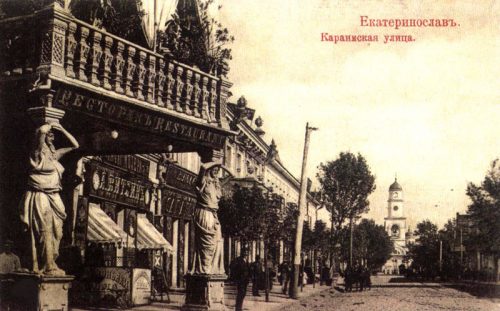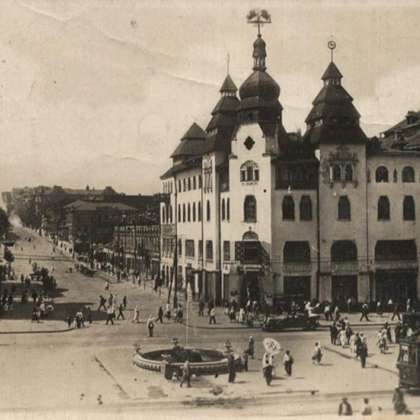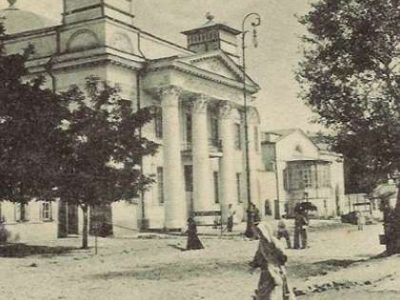Jewish Katerynoslav: The history of a forgotten city

Today on the program Encounters we are discussing Katerynoslav [Formerly also called Dnipropetrovsk, and today Dnipro—Ed.] and the fact that one in every three residents of this city was once Jewish. Today only a few traces can be found of a city that no longer exists.
Ukrainian territories before the Second World War were multicultural. Jews, who formed part of this mosaic, lived mostly in the cities of the Ukrainian gubernias of the Russian Empire. Katerynoslav, which was a large gubernial city at the time, was no exception. The historian Valentyn Rybalka will tell us about Jewish communities, political parties, and pogroms.
Andriy Kobalia: If we are talking about Jewish Katerynoslav and the final tsarist-era years of this city, how many Jews lived there? Say in the years 1911 or 1913. What role did they play in the life of this large gubernial city?
Valentyn Rybalka: We can say that there was a rather significant number. At the beginning of the First World War they comprised around a third of the city’s population. This was a large and influential community. How did Jews come to live in Katerynoslav? The city of Katerynoslav was founded in 1786 with very ambitious plans. It was founded by [Grigory] Potemkin as the third imperial capital and was known as the “Southern Palmyra,” due to plans for the Balkans, and the Turkish plans of Catherine II, who wanted to dominate the Black Sea and gain access to the Mediterranean. However, that did not happen.
As a result of the three partitions of Poland, Russia acquires territories with a very large Jewish community. Catherine II decided to use them during the colonization of the “lands of Novorossiia” located in the southern part of the empire. Katerynoslav was part of this zone. In 1791 Catherine II issues an ukase stating that a “Pale of Settlement” was being created for Jews, which also encompassed the southern lands of the empire. An ukase “About the Granting of Citizenship to Jews in Ekaterinoslav and Tavriia oblasts” was issued that same year.
It was planned that the colonization would be purely agricultural. Lands and funds were allocated, but the kind and scope of colonization as envisaged by the government never took place. There were several objective reasons for this. The Jewish population of the Rzeczpospolita—from the territories of western Ukraine and Belarus—was urban, it lived either in large cities or small towns, but rarely in villages. These urbanites tended to engage in petty trade or crafts. Thus, Jews began to settle the cities located in the southern reaches of the Russian Empire. They appeared in Katerynoslav practically from the moment it was founded.
Andriy Kobalia: With every passing decade the economic influence of the Jewish community increased. This is connected with what?

Valentyn Rybalka: As of 1850, Jews in the city comprised close to nineteen percent of the population. The rise of their influence is connected with the efforts of Oleksandr Pol, thanks to whom the city is transformed into a large industrial center. Such a center needs workers, financiers, traders, these being the Jews’ customary occupations. So, as of 1897, Jews comprised thirty-seven percent of the population of Katerynoslav. In 1926 this number rose to nearly forty percent. However, at this point we must include the events of the First World War and the Civil War. On the eve of the Second World War, that number had dropped to about eighteen percent.
Andriy Kobalia: Jews are known for their wonderful self-organizing ability. Communities that sprang up in cities were able to help poorer members and perform other charitable works. How did this work in Katerynoslav?
Valentyn Rybalka: There was no kahal as such because at the time they were banned in the Russian Empire. Nevertheless, there was a large community here, there were several spiritual centers, and various communities existed. The life of the community revolved around the rabbis. There was a state rabbi and a rabbi who was a spiritual leader. The spiritual leader of the Katerynoslav Jews was Levi-Yitzchak Schneerson. He was the head of the community and the leader of the city’s Jews from 1909 to 1939, and he lived on Barykadna Street. He was the head not only of the Hasidim but all the Jews. He was arrested in 1939, and later exiled to Kazakhstan.
Andriy Kobalia: How were rabbis chosen? Were they invited or were they elected from among the community members?
Valentyn Rybalka: In tsarist Russia, rabbis were elected from within the community in keeping with certain criteria. The candidate had to have completed a rabbinical college, be familiar with the laws of the creeds, and be a respected and authoritative person in the city. But he was supposed to be confirmed by the local administration, which selected only those who were loyal to the empire and its laws. This was the state rabbi.
There was also a spiritual rabbi, who was elected by the community and who dealt exclusively with spiritual matters. According to the law, the spiritual rabbi was the advisor to the state one, but the influence of the former was, in many cases, much greater.
Katerynoslav was a unique city. After the reforms of Alexander II a certain number of Jews were permitted to become functionaries! Whereas in other cities in the “Pale of Settlement” there were practically no Jews in the bureaucracy, in Katerynoslav seven percent were Jews! There were nearly eighty Jewish noblemen in the city, who had acquired this honorary title for their philanthropy, and forty industrialists were honorary citizens of the city.

Andriy Kobalia: You mentioned industrialists. Could you give us some concrete names? Were Jewish industrialists active in a certain branch of industry, like metallurgy for example?
Valentyn Rybalka: Regarding metallurgy, no. Metallurgy belonged to English, Belgian, French, German, and to a lesser extent, Russian capital. In Katerynoslav gubernia nearly twenty-five percent of manufacturing belonged to Jewish industrialists. However, these were rather small businesses: metalworking, the leather industry, and soap factories. In other words, consumer goods. Brick manufacturing was very popular. After the 1880s the city grows rapidly, and a lot of bricks for construction are needed. Many owners of brickworks were Jews. The location also favored this, as there were large deposits of clay in the ravines of the Dnipro River. I can mention the Rabynovyches, the Kohans, and the Bruks; Motskin, the Chechik brothers.
Incidentally, an exhibit was held at our Museum of the Memory of the Jewish People and the Holocaust, and one of the items on display was a collection of Katerynoslav bricks from the late nineteenth and early twentieth century, which was donated to us by the famous Dnipro-area collector Pavlo Mamenko. Most of the bricks are marked by the names of Jewish brick manufacturers.
Andriy Kobalia: A century ago Katerynoslav was known for its wide spectrum of political parties: leftists, ranging from anarchists to Mensheviks, and right-wingers, including the Union of the Archangel Michael. What Jewish political parties were in Katerynoslav?
Valentyn Rybalka: Yes, there were truly many different parties in the city. This is connected with the size of the population and with the fact that the entire social and ethno-confessional structure was represented here. Everyone was in this “cauldron.”
The gymnasium student Gavriil Lindov [pseudonym of the revolutionary and communist Gavriil Leiteizen—Ed.] founded the first Marxist circle in the city. Later, other parties appeared. The Zionist movement also developed here. The Zionist Socialist Workers Union was founded by Ber Borokhov in 1901. He also created a self-defense group, which, following the Kishinev pogrom of 1903, helped ensure that the wave of pogroms skirted the city. It was precisely this group that protected the Jewish population during the pogrom that took place in the fall of 1905. The influence of Zionism was so great that the leader of the Katerynoslav gendarme district noted that the gubernia was covered with a network of Zionist organizations, and the government struggled mostly against them.
In 1913 Vladimir Jabotinsky, a friend of the Ukrainian national movement, gave two public lectures in the city: “The Assimilation of Nationalities” and “National Minorities.” There were also eight hundred members of the Bund here, and nearly a hundred members of Po‘ale Tsiyon. Our museum has a certificate dated 1918, which belonged to a member of the combat squad of the Jewish Socialist Workers Party. At the Founding Congress of the Ukrainian National Republic in 1917 nearly thirty percent of the delegates were Jews.
Andriy Kobalia: Let’s go back twelve years. We know that in the fall of 1905 a wave of pogroms swept through the Russian Empire, and I understand Katerynoslav was not spared. You already mentioned self-defense. Please discuss what happened in Katerynoslav in the autumn of 1905.
Valentyn Rybalka: The pogroms of 1905 were not the first. In 1881 a wave of pogroms swept through the southern part of the empire following the assassination of the liberal-minded Tsar Alexander II. “Jews” were accused of it. As a rule, pogroms took place in cities. Taking part in them were people for whom religious or ethnic background was merely a pretext for robbery.
The pogroms of 1905 are different in that they were organized, not spontaneous. The organizers were monarchical right-wing political forces, specifically the “Union of the Russian People” and the Union of the Archangel Michael. They were quite popular in Katerynoslav. That year nearly forty pogroms took place throughout the gubernia. The largest one took place in the city in October 1905, when approximately sixty-seven people were killed and nearly a hundred injured. In his report to the governor, the police chief of Katerynoslav wrote: “I hereby report to Your Excellency that during the last days of the riots in the city of Ekaterinoslav, 122 stalls, 64 shops, 135 lockers, [and] 40 apartments were smashed and looted, and 5 homes were burned. Jews killed by bladed weapons: 34 men, 9 women, and a little girl. Injured by firearms: 48 Jews.“
There is a now a fashionable vogue among our neighbors [Russia—Ed.] to exalt imperial power. The police chief did not sympathize with the Jews. The pogromists were arrested, but everything ended in absolutely nothing.
Andriy Kobalia: Tsarist Katerynoslav and the Romanov monarchy came to an end in 1917. This was followed by the October coup and the Civil War. A hundred years have passed since then. Where can one see traces of Jewish Katerynoslav today? I have in mind the synagogues.

Valentyn Rybalka: We have the famous Golden Rose Synagogue; it’s the Choral Synagogue. Before 1917 there were more than forty synagogues and prayer buildings in the city. Eventually there were fewer of them, especially after 1929 and the Bolshevik offensive against religious life. The Golden Rose Synagogue was built in 1800, but it was a wooden structure, and it burned down in 1833. At the time, the Jews did not wield such great influence, so the rebuilding took a long time, for the most part through charitable donations. It was opened officially in 1852. It was closed in 1929, in accordance with a decision handed down by the local Soviet organs. It is interesting to note that Christian churches were closed at the same time.
The synagogue was located in the Jewish quarter. Opposite stood the Shelska factory, later renamed the Volodarsky factory, where many Jews worked. They turned the synagogue into the Club of Jewish Shoemakers of Katerynoslav. Later it was a storehouse. The Jewish community fought long and hard to regain the synagogue and the transfer to the community took place in 1996. It was restored and the grand opening took place in 2000.
In the city center are countless buildings that are connected one way or another with Jews. The Jewish community lived in the city center. The main street, Shyroka–Katerynensky Avenue, as well as the side streets, was the Jewish quarter.
Andriy Kobalia: We talked with the historian Valentyn Rybalka about Jewish Katerynoslav.
The program Encounters was made possible by the Canadian non-profit organization Ukrainian Jewish Encounter. Andriy Kobalia was at the microphone and you have been listening to Hromadske Radio. Listen. Think.
Originally appeared in Ukrainian (Hromadske Radio podcast) here.
Translated by Marta D. Olynyk.
Edited by Peter Bejger.
NOTE: The UJE does not necessarily endorse opinions expressed in articles and other materials published on its website and social media pages. Such materials are posted to promote discussion related to Ukrainian-Jewish interactions and relations. The website and social media pages will be places of information that reflect varied viewpoints.



















